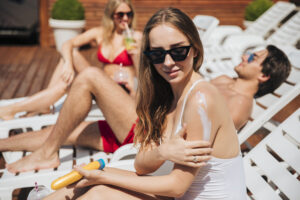Do you know your sunscreen?

Watch out for:
- Oxybenzone – this is a hormone disrupting chemical which penetrates the skin and enters the bloodstream. It is the most popular ingredient in chemical based sunscreens and only blocks UVB ray (sun’s good rays that provide vitamin D production), not UVA which are the most free radical damaging rays. Avoid any sunscreen that has this chemical at all costs, especially for children.
- Vitamin A (Retinyl Palmitate) – A 2009 study by U.S. government scientists released by the National Toxicology Program found when this is applied to the skin in the presence of sunlight, it may speed the development of skin tumors and lesions.
- Fragrance – Sure it may make the product smell nice, but this is a petroleum based product that is linked to organ toxicity and allergies.
- High SPF – The FDA does not regulate SPF higher than 50 and there’s no scientific proof they work better than lower SPF. Many of the higher SPFs do not provide any additional protection and studies have suggested that users are exposed to as many or more ultraviolet rays as those who use lower-SPF products.
- Sprays or Powders – Generally speaking, sprays and powders have additional chemicals added to them for performance purposes. These additional chemicals are usually not something you want to be spraying on your body and can be toxic to the lungs. Besides, remember sunscreen is formulated for your skin, not your lungs. Many of the side effects of sprays and powders on the lungs are not tested before being approved.
- Popular Conventional Brands – Aveeno, Banana Boat, Coppertone Sport, Coppertone Water Babies, Bull Frog, Neutragena, Storebrands (CVS, Rite Aid, Walgreens), Hawaiian Tropic and many other popular brands are rated the worst in terms of safety in the Environmental Working Group’s Sunscreen Guide. You can use this guide to find out how good or bad the brand you have or want to buy is rated.
How To Choose A Safe Sunscreen:
- Look for titanium dioxide and zinc oxide based mineral sunscreens, which do not penetrate the skin and provide UVA protection against the sun’s most damaging rays.
- Choose non-nano products that do not have small particles that can absorb into skin
- Choose sunscreens that are unscented or use essential oils as fragrance
- Pick lotion based sunscreens with water resistance
- Pick broad spectrum sunscreens that protect against UVA and UVB rays
- Choose sunscreen products that are rated 0-2 in the Environmental Working Group’s Sunscreen Guide.
Check out my own personal Arbonne link http://nicksmith.arbonne.com to see some of the safest sunscreens and other Arbonne products that are Botanically based and free of Toxins! Find out about their discounts from 20 up to 35%!

Comments are Closed